Located on scenic Lake Shore Drive in Chicago, Soldier Field was designed in 1919 and opened on October 9, 1924, as Municipal Grant Park Stadium. The stadium--modeled in the Greco-Roman architectural tradition with classic Doric colonnades--was designed by the Chicago architecture firm Holabird and Roche as a memorial to American soldiers who died in World War I and previous wars. Soldier Field has been the home of the Chicago Bears team since 1971; it served equally as a civic and athletic venue throughout the early and middle 20th century. It played host to the Army-Navy game in 1926, the second heavyweight boxing championship between Jack Dempsey and Gene Tunney in 1927, speeches by Charles Lindbergh and Franklin D. Roosevelt, rodeos, circuses, the first Special Olympics in 1968, the 1994 World Cup, and the final concert by the Grateful Dead. In 2001, the Chicago Park District faced criticism when it announced plans to renovate the stadium, which had been listed in the National Register of Historic Places since 1987. An extensive remodeling plan was initiated and the "new" Soldier Field drew mixed reviews when it reopened in 2003. After being rebuilt, the modern stands dwarfed the historic Doric columns, and seating was reduced by approximately 5,000, to 61,500.








